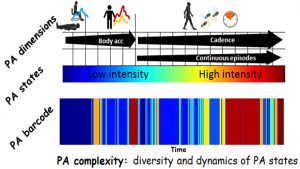Overview
Developed in the context of ‘physiological complexity’, the concept of movement and physical activity (PA) complexity postulates that healthy status is characterized by freedom of movement in terms of flexibility, ability to successfully achieve daily tasks, physical performance, variation of activities, and participation in social. On the other side, aging and chronic diseases may be characterized by progressive movement impairment, difficulties with daily tasks, limitation of activities & social life. Beyond traditional measures such as cumulated activity levels and bout durations, the focus is therefore on the complexity of PA pattern (‘barcode’) aiming to quantify the diversity and temporal dynamics of PA states, defined as combinations of basic PA dimensions (type, intensity, duration).
Chronic Pain Project
- Contact person: Anisoara Ionescu
- People involved: Anisoara Ionescu
- Partners:
- Funding source: Fondation de l’hôpital de Morges
Chronic pain is a complex disabling experience that negatively affects the cognitive, affective and physical functions as well as behavior. Although the interaction between chronic pain and physical functioning is a well-accepted paradigm in clinical research, the understanding of how pain affects individuals’ daily life behavior remains a challenging task. Theoretical models of chronic pain behavior suggest however that in addition to pain intensity other factors such as adopted coping strategies and/or pain etiology may affect the patterns of every-day life physical activity behavior.
The objective of the ongoing study is to collect supplementary data and develop analytical methods allowing to improve the assessment of chronic pain conditions.
Healthy Aging Project (PreventIT)
- Contact person: Anisoara Ionescu
- People involved: Anisoara Ionescu, Wei Zhang, Gaelle Prigent
- Partners:
- Funding source:Horizon 2020
Healthy ageing can be described as a lifelong process optimizing opportunities for improving and preserving health and physical, social and mental wellness, independence, quality of life and ability to adapt to the demands of everyday life. While this definition depicts healthy ageing as a complex process of adaptation to physical, social and psychological changes across the lifespan, the concept needs to be characterized in terms of a measurable outcome to be empirically valid. Due to its capacity to characterize the dynamics of behavioral systems, the emerging field of complex adaptive systems and its array of quantitative tools show great promise for improving our understanding of aging, monitoring frailty process, and providing outcome measures for evaluating novel interventions that promote healthy aging.
